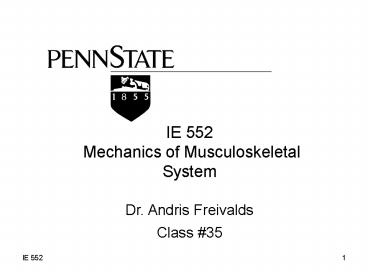My Class - PowerPoint PPT Presentation
1 / 46
Title:
My Class
Description:
Gross Posture Analysis OWAS. Owaco Working Posture Analysis System ... Details - Seth, Weston, Freivalds (1999) IE 552. 26. IE 552. 27. PSU CTD Risk Index - 2 ... – PowerPoint PPT presentation
Number of Views:92
Avg rating:3.0/5.0
Title: My Class
1
IE 552 Mechanics of Musculoskeletal System Dr.
Andris Freivalds Class 35
2
Gross Posture Analysis OWAS
- Owaco Working Posture Analysis System (OWAS,
Karhu, 1977) - Developed at the Finnish Institute of
Occupational Health in 1970s - For use in steel industry
- Evaluation of posture at regular intervals
- Four categories back, upper limbs, lower limbs,
force (lt10, lt20, gt20 kg)
3
2151 bent back, both arms below shoulders,
kneeling, lt10 kg load
4
Gross Posture Analysis OWAS
- Next produce frequency distributions of OWAS
postures - Rate into four level of action categories
- Test-retest correlations high, r 0.97
- Quick but simple means of categorizing gross
postures
5
Gross Posture Analysis - RULA
- Rapid upper limb assessment (RULA)
- Developed at the Univ. of Nottingham
- (McActamney and Corlett, 1993)
- Upper limb postures from Group A Table A yield
an upper limb score - Trunk/leg postures from Group B Table B yield a
trunk score - Both scores combined into grand score
- Determines risk or action level
6
RULA Group A
7
RULA Table A
8
RULA
- These scores are adjusted upwards
- 1 if mainly static posture (gt1 min) or
. repeated gt 4/min - 1 if 2-10 kg intermittent loads
- 2 if 2-10 kg static or repeated loads
- 3 if gt10 kg static or repeated loads
9
RULA Group B
10
RULA Table B
11
RULA Grand Score Table
12
RULA
- If RULA grand score
- 1 or 2 acceptable conditions
- 3 or 4 change may be needed
- 5 or 6 change required soon
- 7 or 8 change required immediately
- Good correlation with discomfort
- Probably best for postural evaluations
- Example t-shirt turning, 12/min
13
(No Transcript)
14
RULA A 4 1 (Freq gt 4/min)
15
1 due to static posture
16
Grand score 4, Borderline risk
17
(No Transcript)
18
Quantitative Upper Limb WRMSD Risk Assessment
Strain Index 1
- Strain Index (SI, Moore and Garg, 1995)
- Rate 6 task variables (Table 1)
- intensity of exertion
- duration of exertion
- efforts per minute
- wrist posture
- speed of work
- duration of task
19
Strain Index Rating Criteria Table 1
20
Strain Index Multipliers - Table 2
21
Strain Index - 2
- Convert SI ratings to multipliers (Table 2)
- Multiply for final SI score
- Scores gt 5 considered hazardous
- Good validation
- identified 24/25 risky/non-risky jobs
- sensitivity 0.86
- specificity 0.79
22
Strain Index - 2
- Example using Strain Index
- Consider task with
- 20 MVC exertions
- over 60 of a cycle
- with 12 efforts per minute
- with 18 ulnar deviations
- at 95 of normal pace
- for a full 8-hr shift
23
(No Transcript)
24
Quantitative Upper Limb WRMSD Risk Assessment
- The example job is hazardous (13.5gt5)
- Overall, SI improvement over RULA
- Considers more than basic postures
- Considers upper extremities
- Considers effort, intensity, pace
- Greater quantitative detail
- Next step ? data driven risk models
25
Data Driven Upper Limb WRMSD Risk Assessment
PSU CTD Risk Index
- Developed at Penn State University
- From 13 years of Center for CTD work
- Wrist postures fed directly to model
- From touch glove system (using force sensitive
resistors and Data Glove) - Industrial WRSMD data tunes model
- Final score - predicted incidence rate
- Details - Seth, Weston, Freivalds (1999)
26
(No Transcript)
27
PSU CTD Risk Index - 2
- Validation on 24 jobs with 288 workers
- Regression of predicted vs. actual IR
- Significant (p lt 0.001) correlation, r2 0.52
- By 5th trial, analysis time down to 12 min.
- Test/retest reliability was up to r20.99
- 2nd validation on 91 meatpackers, r2 0.75
28
PSU CTD Risk Index
r2 0.52
29
(No Transcript)
30
PSU CTD Risk Index - 3
- Also a paper and pencil version
- Quicker, simpler to use for industry
- No direct angle of force measurements
- Workers estimate force, analyst - angles
- Validated with PC version
- On 12 sewing jobs
- Significant (p lt 0.001) correlation of scores
with r2 0.66 - Action level 1.0 (similar to NIOSH Lifting)
31
Task Force (T) vsPerceived Force (P)
32
(No Transcript)
33
PSU CTD Risk Index P/P 1
34
PSU CTD Risk Index P/P 2
35
PSU CTD Risk Index P/P 3
36
Videoclip Analyses
- Study videoclips
- Analyze using
- Strain Index
- PSU CTD Risk Index paper
- PSU CTD Risk Index PC
- Compare, discuss
37
(No Transcript)
38
(No Transcript)
39
(No Transcript)
40
(No Transcript)
41
(No Transcript)
42
(No Transcript)
43
(No Transcript)
44
Summary
Type of WRMSD Risk Analysis Range Action Level Stitch
Strain Index 0.1-1053 5 20
CTD Risk Index P/P 0 - 4 1.0 1.46
CTD Risk Index - PC 0 300? IR? 12.8
45
OCRA and HAL
- OCRA exposure index complicated
- HAL TLV for hand activity level
46
Comparison of Various Tools
Tool Equip Posture Force Freq Learn Time Anal Time T/RT r Valid r
OWAS P/P Sh3 3 time Short Short 0.74-0.99 -
RULA P/P S5, El3 W3 4 2 Med Short - -
HAL P/P - 10 10 V.short V.short - -
SI P/P 5 5 5 Med Short - 86se 79sp
PSUCTD P/P 2-4 Cont Cont Short Med - r20.66
PSUCTD PC SEW5-7 Cont Cont Long Long 0.72 r20.52

